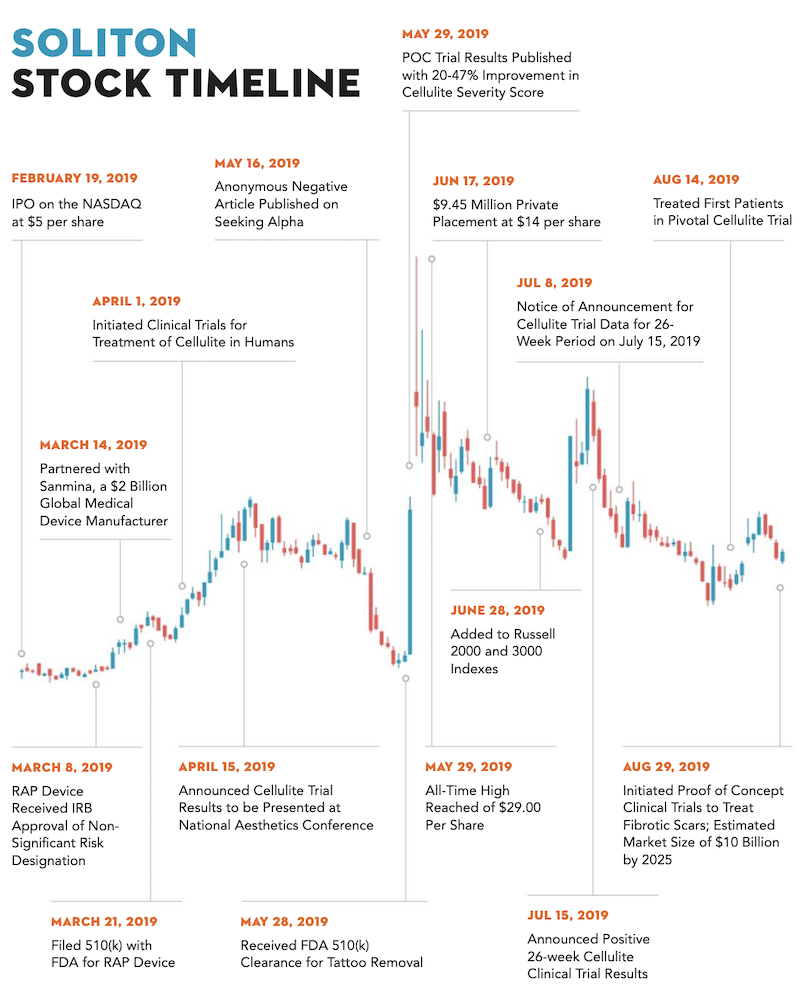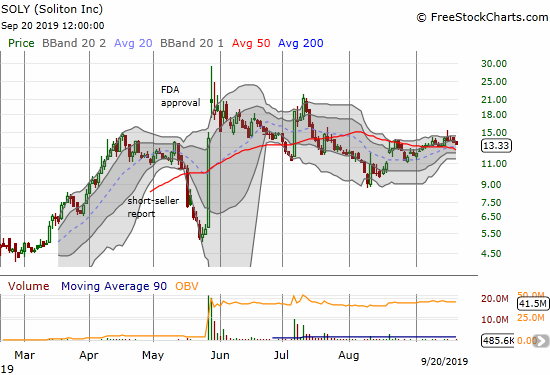The wait continues for Soliton (SOLY) to turn promise into profits through the science and business of tattoo removal.
Shareholder Letter
Soliton recently released its first shareholder letter as a publicly traded company. The report discussed a lot of exciting progress on core technologies and product development, but the letter left shareholders little closer to understanding when and how this work will show up in the top and bottom line of financial results. The letter simply indicated that Soliton plans to start recognizing revenues “as early as mid-2020”. The company expects its Rapid Acoustic Pulse (RAP) device to become a standard of care in a market that should grow to $4.8B by 2023. The letter also included a handy timeline for Soliton’s stock.

Source: Soliton Shareholder Letter
Financial Results
To get a better sense of the company’s financial health and prospects, shareholders need to refer to the 10Q which covers results through June 30, 2019. Since SOLY is not yet making money, the cash burn is the most important thing to understand about the financial results. SOLY stated that “based on our current plans, we estimate our cash resources, including cash on hand of $11,387,168 at June 30, 2019 is sufficient to fund our operations into but not beyond May 2020…” Given the company will not start earning revenues until around that time, Soliton will very likely issue more shares for funding operations. That event presents a future risk for the price of the stock.
The 10Q makes clear that Soliton will need to raise additional funds:
“The Company also believes it will need to raise additional capital in order to continue to execute its business plan, including obtaining additional regulatory clearance for its products currently under development and commercializing and generating revenues from products under development. There is no assurance that additional financing will be available when needed or that management will be able to obtain financing on terms acceptable to the Company. A failure to raise sufficient capital will adversely impact the Company’s ability to meet its financial obligations as they become due and payable and to achieve its intended business objectives. If the Company is unable to raise sufficient additional funds, it will have to scale back its operations.”
The last funding round went through a private investment in public equity (PIPE) on June 16, 2019. Soliton sold shares to private investors through a private placement of shares and warrants exercisable at $16/share. Soliton bundled this offering into a “unit” costing $14 each with one share and 0.7 of a warrant per unit. This sale was timely as SOLY was still benefiting from the great run-up on May 28th.
The stock soared 16.4% the day after the PIPE and closed at $16.64. Since then, the stock has only traded above this level for six days. From a technical standpoint, SOLY looks like it is consolidating around its flattening 50-day moving average (DMA). While I expect SOLY to experience additional days of sharp upward rallies, the 50DMA will likely act like a magnet for SOLY until the financial potential of the company takes on more clarity.

Source: FreeStockCharts
In the last quarter, Soliton spent $2,975,326 on operating expenses. A whopping 71% of that money was spent on general and administrative (G&A) expenses. Most of the rest of the money was spent on research and development (R&D) at 26%. This was a complete flip from the year-ago quarter when the company spent $2,314,131 on operating expenses, 36% on G&A and 60% on R&D. Soliton explains the ramp in G&A as follows (emphasis mine):
This increase was primarily due to increases in salaries and related expenses of $278,986, largely due to the payout of bonuses and the accrual for management incentives (versus a prior year reversal) of $359,843 offset by a decrease in salaries and wages of $80,857, increases in investor relations of $115,802, legal expenses of $113,308, accounting and other professional services of $97,758, insurance of $76,661, travel of $58,239, board related fees of $43,388, and other expenses of $19,503, offset by decreases in expenses for information technology costs of $12,160 and dues and memberships of $8,709. Further contributing to the increase in G&A were the non-cash expenses related to stock options, restricted stock and acceleration of restricted stock vesting due to our IPO of $484,339.
Soliton seems to suggest that R&D expenses were brought down to accommodate the above described expenses that went into the initial public offering (IPO). I will look for the report on the current quarter’s financials to provide a better sense of the on-going (normalized) burn rate for the company. Given Soliton is still a research and development company, I am hoping to see R&D regain its relative importance in expenses.
Indeed, Soliton suggests that R&D costs will soon head upward:
We expect our research and development expenses to increase in the future as we advance our product into and through clinical trials, pursue additional regulatory approvals of our product in the United States, and continue commercial development of our RAP device and replaceable cartridge. The process of conducting the necessary clinical research to obtain regulatory approval is costly and time-consuming.
Accounting Red Flag
The one truly red flag I saw in Soliton’s report was the disclosure of poor accounting controls.
“…our CEO and CFO have concluded that, as of June 30, 2019, our disclosure controls and procedures were not effective. Disclosure controls and procedures include, without limitation, controls and procedures designed to ensure that information required to be disclosed by an issuer in the reports that it files or submits under the Exchange Act is accumulated and communicated to the issuer’s management, including its principal executive officer and principal financial officer, or persons performing similar functions, as appropriate to allow timely decisions regarding required disclosure.
Based on the evaluation, our management concluded that our internal controls over financial reporting were, and continue to be ineffective, as of June 30, 2019 due to material weaknesses in our internal controls due to the lack of segregation of duties, the limitations of our financial accounting system to properly segregate duties, and the absence of internal staff with extensive knowledge of SEC financial and GAAP reporting.
Soliton management included reassurances that they are hiring the necessary expertise to correct these shortcomings. Regardless, this disclosure means that more experienced staff may find some material mistakes which could cause a slight downgrade of the financial health of the company (mainly a revelation of a higher burn rate). Since the company is not yet making money, I expect any such revelations to result in an accelerated timeline for raising funds but nothing catastrophic.
Risk Factors
Techniques employed by short sellers have in the past and may in the future drive down the market price of our common stock.
Soliton spent a considerable amount of ink explaining short-selling and discussing the risks posed by short sellers. It was a short-seller report that took down the stock in May and created the big buying opportunity that first attracted me to the stock.
Soliton explained their vulnerability to short attacks:
“Issuers such as Soliton, that have common stock with limited trading volumes and/or have been susceptible to relatively high volatility levels, can be particularly vulnerable to such short seller attacks…If we continue to be the subject of unfavorable allegations, we may have to expend a significant amount of resources to investigate such allegations and/or defend ourselves. While we would strongly defend against any such short seller attacks, we may be constrained in the manner in which we can proceed against the relevant short seller by applicable state law or issues of commercial confidentiality. “
As the deep sell-off in May demonstrated, the risks of a short attack are very real and very material. Soliton does not make money and is still working on the relevant research and approvals to get its product to market, so it is very easy to question the viability of the company.
Soliton bears are still crowded into the stock with 23% of the float sold short as of August 14th.
Trading/Investing Plan
Soliton is a promising company with a high-risk profile. I still think the risk/reward outlook makes SOLY worth buying on dips, but it also makes SOLY hard to hold during or after extreme rallies.
I have not yet returned to SOLY. I meant to buy in around $10 in August, but the stock recovered faster than I could pull the trigger. With the stock now presumably stabilizing, I will make a small purchase in the coming week or two for a core position. From there, I will get more diligent about buying dips, especially to and through $10. There are enough lingering and looming risks from accounting issues, short-sellers, and regulatory approvals to convince me to stay conservative and cautious at current price levels.
Be careful out there!
Full disclosure: no positions

Internal controls issue frequently cause a future restatement of previous results. Since the company has never made money, as you said this doesn’t seem likely to be catastrophic, but it could produce a buying opportunity that persists for at least one reporting quarter.
That’s my thinking….a restatement would cause a quick drop in the stock as trigger-happy sellers (and shorts) step in to take the stock down. Need to keep some dry powder in case that happens.